How to identify a (truly) healthy upholstery fabric
(is it even possible?) Finding ‘safe’ upholstery fabric remains a challenge, even in these days of increased emphasis on eco-friendly alternatives that claim to protect human health & the environment. Is it too much to ask for fabrics that are stain resistant, wear well, and are also healthy?
YES. Unfortunately, it is (mostly).
When I look through the upholstery fabric sample books in my shop, the paradox is real. If it’s stain resistant, then I know it’s likely to contain PFAS. Most list California Bulletin 117 on the label, I know it may very well contain toxic Flame Retardants.
Let’s consider the extreme: The ONLY upholstery-weight fabrics that are available right now with GOTS (organic) certification are those sold by Two Sisters Ecotextiles. These fabrics are as pure as upholstery fabrics get, and I feel a certain comfort when I handle them – not to mention peace of mind.
For the most part, the paradox of ‘healthy upholstery fabrics’ underscores the need for all of us to be asking the deeper questions, like “Does upholstery HAVE to be bomb-proof?”
In the current market (2020), fabric companies that supply the bulk of upholstery shops are marketing for convenience – stain resistant fabrics are in demand, whether for families with kids and pets, or for heavy commercial use. The result is a large selection of easy-clean, durable fabrics that are NOT HEALTHY – eg. laden with chemicals – many of which have been proven to cause illnesses such as autism, cancer, and infertility.
The best promise we can expect of these products – for protecting the planet and our families’ health – is ‘REDUCED Environmental Impact’, which touts the absence of certain toxic ingredients, but leaves the rest of the thousands of chemicals used in the textile industry on the table (or IN the fabric).

This is not to say these claims are in any way bad, or undesirable: I will certainly choose a fabric with this label over one that does not make such claims. We do have one legitimate indicator for gauging healthy upholstery fabrics, and that is CERTIFICATIONS.
Making sense of certifications
The benefits of green product certifications
Consumers are becoming more informed about product ingredients, sources, and manufacturing, while at the same time growing increasingly skeptical of greenwashing. The ‘smart shopper’ looks for labels and ratings to verify a company’s sustainability claims.
Third-party certification is a way for textile companies to add credibility to their products. Since the process of achieving certification is usually quite costly and time consuming, certifications also add a layer of accountability and integrity for the company. Review by an independent and unbiased third party is currently the most reliable method of verifying claims of product “greenness.”
There is no universal “green product” definition
Don’t we WISH!?!
The effort to verify green product claims has led a global movement by organizations to establish wide ranging (and sometimes competing) green product evaluation systems. This can create confusion for the end user.
As fabric consumers, our challenge becomes sorting through the hundreds of certifications out there and figuring out which ones we are most likely to encounter in the upholstery or design workroom. Hat tip to Oecotextiles blog, whose work is supported by scientific research citations, for doing most of the sorting FOR me on this post. Three questions helped me decide which certifications to consider:
- WHO should I trust? I would hesitate to place my trust in certifications that are created by any company that does not utilize outside (3rd party) monitors. This is the fox guarding the henhouse.
- WHAT exactly is being certified? There are many attributes of a product that might affect our health. For instance, VOC’s pollute our indoor air, heavy metals and PFAS build up in our bodies and in the environment, and Pthalates disrupt hormonal function. It’s often just one attribute or part of the process that carries a certification. This does not make the certification any less valid, but represents an incomplete assessment that’s likely to allow other ‘nasties’ to slip through, and thus compromise the very thing we are trying to protect against.
- WHERE is the certification showing up? When looking only at certifications that are specific to upholstery fabrics, we find a handful of certifications that one might encounter in an upholstery workroom. I have chosen six to list here, with short descriptions for each + links you can follow to explore further.
Six Certifications
Here are six certifications that may be applied in textiles that end up as upholstery fabric:
- GOTS: Global Organic Textile Standard
- OekoTex Standard 100
- GreenGuard
- Cradle to Cradle
- SMaRT Sustainable Textile Standard
- Global Recycle Standard
1. GOTS: Global Organic Textile Standard 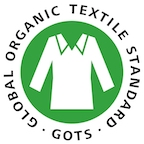
The expense of obtaining and maintaining this certification drives the cost of the fabric up, to a point where the larger upholstery fabric supply houses are unwilling to carry them due to low profit margins. For this reason GOTS certified fabrics are rarely even available for designers and upholstery workrooms to carry, but they are often available directly from the producer. See the end of this post for a fabric resource list.
- GOTS is the result of a collaborative international effort to codify textile standards to offer consumers and manufacturers a transparent, trusted certification.
- The GOTS certification applies to only natural fibers, it cannot be applied to polyester or other synthetic fibers.
- GOTS evaluates all stages of fabric production – from harvesting the raw materials, through production, processing, manufacturing, packaging, labeling, exportation, importation and distribution – taking into account environmental and social justice elements in each step.
- GOTS provides a continuous quality control and certification system from field to shelf. There are also social responsibility components (eg. fair wages, no forced labor, etc.)
- GOTS is transparent – all parameters are listed and accessible.
- Conformity is verified by a 3rd party independent organization through on-site inspections.
The FIBER vs FABRIC distinction
Some certifications found on fabrics may only pertain to the FIBER, and not to the PROCESS which produces the final fabric. This is a vitally important distinction to make because conventional (non-certified) PROCESSES by which fabric is made:
- CAN and most often DO introduce dangerous chemicals into the fabric itself AND into the groundwater through factory effluent.
- May include child labor or unsafe working conditions for workers.
To illustrate, let’s take a bolt of fabric that’s “made from organic cotton” fiber. The fiber is certified organic, but the finished fabric is not, resulting in a fabric that is likely to contain a high proportion of toxic chemicals from solvents, dyes, and finishes. These could include heavy metals such as lead or mercury, and other dangerous substances such as formaldehyde, chlorine, or phthalates.
In other words, a fabric “made from organic cotton” – if processed conventionally (in a non-certified production facility) – is likely to be full of chemicals which may be prohibited in a truly organic fabric and which are known to wreak havoc in human health.
Display of the GOTS logo
The GOTS certification has strict environmental and social criteria for operations along the entire textile supply chain.
A GOTS logo on any product means that all processing ‘from field to final product’ is GOTS certified. So a GOTS certified cotton thread can carry the logo, but if that thread is used to weave a fabric in a non-certified factory, the final fabric cannot display the logo. So when you see a GOTS logo on a product, you can rest assured that the entire supply chain has been certified (see GOTS flyer).
2. OekoTex Standard 100 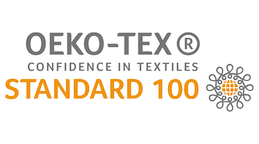
The Oeko-Tex Standard 100 is a more common certification than GOTS in upholstery fabrics. It is not as rigorous, but still excludes harmful substances or limits their use, and assures safety.
- OekoTex was founded to provide an objective and reliable product label for consumers and a uniform safety standard for the assessment of harmful substances in fabrics.
- OekoTex Standard 100 is a globally uniform testing and certification system for textile raw materials, intermediate, and end products, at all stages of production.
- Oeko-Tex Standard 100 specifically tests for and bans the most egregious offenders of human health, including AZO dyes, formaldehyde, pesticides, phthalates, chlorinated phenols, extractable heavy metals, and more.
- Oeko-Tex Standard 100 tests for emissions of volatile components (VOC’s)
- The Oeko-Tex Standard 100 certification DOES NOT look at the processing, manufacturing or social requirements (wastewater treatment, renewable energy, child labor). It is solely concerned with the final product.
- Conformity is verified by a 3rd party independent organization.
Leather Standard
Oeko-Tex has added several other standards since the Oeko-Tex Standard 100 was established. Of note is a Leather Standard which is likely to be encountered in a design or upholstery workroom alongside Standard 100 fabrics. Other standards include more stringent requirements that consider environmental and social impacts.
End user verification
Each of the Oeko-Tex standards carries a label with a number. You can check whether a certificate is still valid based on the certificate numbers by entering the number in the corresponding standard’s label-check section of their website.
.
3. GreenGuard 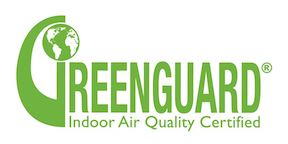
Greenguard is not designed specifically for fabrics, but a fabric can be GreenGuard certified, and therefore shows up as a certification on fabrics you might find in upholstery shops.
- GreenGuard tests ONLY for emitting chemicals which are a gas at room temperature.
- GreenGuard does NOT look at fabric production, social justice issues (such as child labor), carbon footprint, heavy metals, PVC or phthalates (except in the Children and Schools certification).
Examples of Greenguard certified fabrics include Mayer fabrics & Knoll.
.
4. Cradle to Cradle 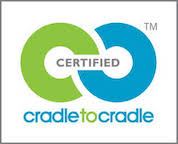
Cradle to Cradle (C2C) certification is included here because it has been approved for a few upholstery fabrics that you may encounter at an upholstery shop, design firm, or online fabric vendor.
.
- C2C is associated with respected thought leaders such as William McDonough.
- C2C certifies only the product, without considering end use.
- C2C has an energy, water and social responsibility component.
- All ingredients in a C2C certified product are identified down to 100 parts per million (ppm) and assessed according to 19 human and environmental health criteria.
- C2C primarily certifies that the product uses environmentally safe and healthy materials. However the list of what is considered safe is proprietary. This lack of transparency makes it impossible for the end user to make an informed judgement on whether the fabric falls within their chemical content threshold, especially if they are chemically sensitive.
- Oecotextiles blog points out the “lack of boundaries between the C2C standards developing body, the C2C certification body and the MBDC consulting body” which throws into question the claim that C2C is a true 3rd party certification.
.
5. SMaRT Sustainable Textile Standard 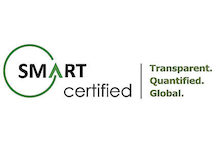
Sustainable Materials Rating Technology (SMaRT) has rules in place which prevent potential issues related to industry trade association dominance within the certifying body. This imparts an extra layer of transparency. SMaRT certification has been approved for upholstery fabrics that may be found in upholstery & design workrooms (eg. Knoll fabrics).
.
- SMaRT is administered by MTS (The Institute for Market Transformation to Sustainability), which specifies transparent, consensus based sustainable product standards.
- SMaRT evaluates all product stages.
- The SMaRT Sustainable Textile Standard requires tracking and mitigation of 1300 chemicals.
- Environmental, social and economic performance criteria are defined and quantified in areas such as renewable energy, climate change, habitat alteration, ozone depletion, fossil fuel depletion, indoor air pollutants, and water pollutants.
- SMaRT has been adopted by trusted green organizations such as the US Green Building Council and is recognized by LEED Green Building Standard.
- Conformity is verified by a 3rd party independent organization.
.
6. Global Recycled Standard (GRS) 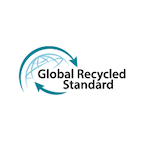
The goal of the Global Recycled Standard is to increase the use of recycled materials. This standard allows certification of synthetic fibers as well as natural fibers, and thus may be more commonly encountered in upholstery workroom fabric stock.
.
- Global Recycled Standard works with companies looking to verify the recycled content of their products.
- GRS verifies responsible social, environmental and chemical practices in fabric production.
- The certification ensures accurate content claims.
- GRS requires consistent definitions of recycled across multiple applications.
- Provides assurance that products are processed more sustainably.
- Conformity with GRS standards is verified by a 3rd party independent organization
Global Recycled Standard Resources
.
The Bottom Line

CAN we have fabrics that are stain resistant, wear well, and are also healthy?
Unfortunately, the answer is mostly “NO”. The important point in this entire upholstery textiles conversation is not one that many of us in the business like to hear. As designers, architects and upholstery professionals, it is up to us to educate ourselves and our clients about the TRUE COST of our fabric choices. Human & environmental exposure to chemicals in furniture is like the iceberg that is hidden beneath the ocean surface. The sooner we call it out, the better our prospects will be for protecting the welfare of all.
The textile industry has been largely allowed to self-regulate. Granted, some visionary players are making changes, but most shifts move at a snail’s pace. Industry trends toward ‘reduced’ or ‘safer’ chemical use are not enough. Current climate change and human health indicators underline the need for more meaningful steps toward health, social, and environmental protections.
There are some steps you can take RIGHT NOW to accelerate change.
Be proactive
The textile industry as a whole is currently one of the biggest polluters on the planet. Ultimately, it’s up to each of us individually to be proactive in generating greater demand for safe, certified fabrics. Here are some actions you can take:
- Vote with your dollars. Purchase certified fabrics whenever possible.
- Request certified fabrics wherever you shop. Even if there’s little likelihood of finding exactly what you need, it’s important to communicate the message.
- Educate yourself. Learn how the fabrics you use affect your own health, your family’s health, and your client’s health (see links below). Then tell others: your friends, your family, and your clients.
Learn more:
This post is a follow-up to Greening your Textile Choices, an exploration of the why & how of environmental & health effects of ‘conventional’ upholstery fabrics on the market today.
Certifications are a tiny part of the big picture. Check out this eye-opening look at the state of the industry regarding chemical management in textiles today (podcast).
For a detailed look at how the certification process works, see the Textile Exchange’s Certification Toolkit.
Thank you to the Two Sisters Ecotextiles blog, from which I’ve sourced some of the information in this post. To read their more detailed account of these certifications, check out Certifications – What to look for in textiles.
See Healthy Materials Lab to learn how chemicals in materials can effect human health (a great quick overview of the basics)
Check out Natural Upholstery’s fabric resource page, where I’ve begun a list of sustainable fabrics. I look forward to hearing your suggestions for additions to this list.
Join the conversation! Subscribe to my newsletter, and feel free to leave any questions in the comments below.
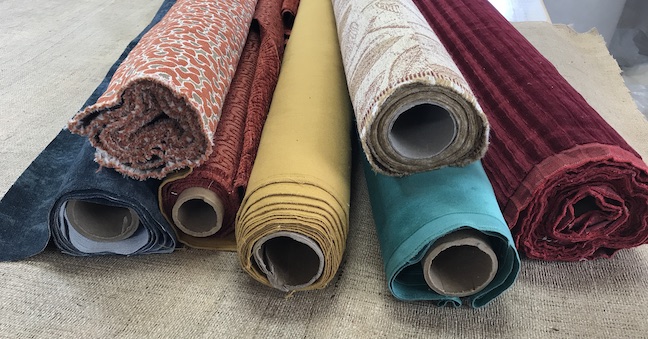
Leave A Comment